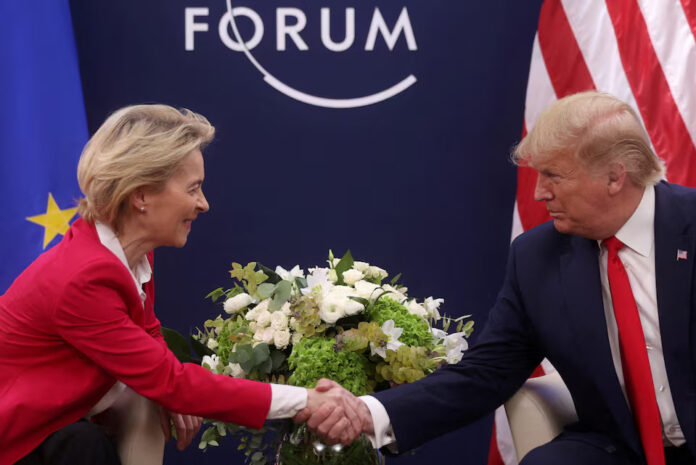
With just days remaining before a key U.S. tariff deadline, investors are closely monitoring the outcome of high-level talks between the United States and the European Union, as hopes grow for a trade agreement that could bring greater stability to global markets.
European Commission President Ursula von der Leyen is scheduled to meet U.S. President Donald Trump on Sunday in Scotland, where EU diplomats and officials believe a framework deal could be reached over the weekend. The meeting comes amid intensifying negotiations aimed at averting steep new tariffs that are set to take effect on August 1.
President Trump, speaking on Friday, characterized the chances of a deal as “50-50, or perhaps less,” though EU officials have expressed cautious optimism about finalizing at least the outlines of an agreement.
According to sources familiar with the negotiations, the proposed deal may include a 15% baseline tariff on all EU goods entering the U.S., along with a hefty 50% levy on European steel and aluminum. Currently, the EU faces a wide array of U.S. tariffs covering more than 70% of its exports: 50% on steel and aluminum, 25% on cars and car parts, and a 10% levy on most other goods, all of which Trump has threatened to raise to 30% if no agreement is reached by the August 1 deadline.
The high-stakes trade discussions come as investors brace for increased market volatility. “It’s one of our largest trading relationships,” said Sameer Samana, head of global equities and real assets at the Wells Fargo Investment Institute. “So if that last piece falls into place, then you’ve probably got at the margin more people that have to get back in the markets. It’s been a source of uncertainty that will go away.”
Recent signs of easing trade tensions, including a new trade agreement with Japan earlier this week, have helped propel U.S. stock markets to record highs. Analysts say progress with both Japan and the EU is particularly meaningful, as the two economies together account for roughly 25% of U.S. goods imports.
“The deal with Japan and the likely one soon with the EU are especially important given both are major U.S. trading partners,” analysts at Capital Economics wrote in a Friday research note.
The stakes are high not only for investors, but also for businesses and consumers on both sides of the Atlantic. Trump’s abrupt April 2 announcement of sweeping global tariffs, dubbed “Liberation Day” by his administration, initially rattled markets and sparked fears of a global slowdown. Those concerns have since eased, but the looming tariff deadline has once again injected uncertainty into financial and trade circles.
As Sunday’s meeting approaches, markets remain cautiously optimistic that a deal will be reached, one that could not only avert a tariff escalation, but also bring much-needed clarity to one of the world’s most critical economic relationships.
Written By Rodney Mbua


















